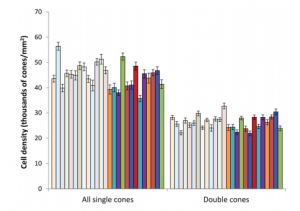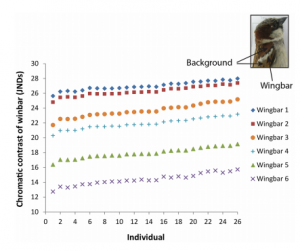Evolution through natural selection spends on variation of a trait within a species. Variation of a certain trait that has implications for Darwinian fitness within a species can lead to a population level shift towards one phenotypic realization of the trait over another. The visual system is an example of a system wherein variation can have important implications for fitness and behavior, as it is an important means of reducing uncertainty in a diverse array of situations important for an individuals survival. Such intraspecific variation of visual systems can occur at different levels including between populations, morphotypes and sexes. However, these between-individual variations must be taken in the context of within-individual variations, for example, photoreceptor densities vary within an individual between the left and right eye, as well as variation in different areas of the retina. Ensminger and Fernàndez-Juricic (2014) investigated the degree of between-individual variation in cone photoreceptor densities of house sparrows in the context of within-individual variation. The density of cone photoreceptors affects both chromatic contrast (the perceived degree of contrast between two surfaces based on chromatic cues) and visual or spatial resolution (ability to tell apart two separate objects in the visual field). Chromatic contrast in sparrows is determined, among other factors, by the relative densities of the four cone types contained in avian visual systems, by opponency pathways that allow for color comparisons. Visual resolution is determined, among other factors, by the absolute density of photoreceptors because when cones are closer together, light is only received from a restricted range of angles and the retina is able to make more comparisons to resolve individual objects. These qualities are important to a sparrow’s behavior due to the use of visual signals, especially in mating and aggressive interactions. For example,a wingbar that highly contrasts with the wing, as shown in figure 1, is a dominance signal. This study looks takes a unique approach in that it looks at variations in the receivers perception of the wingbar rather than variations in the visual signal exhibited by the wingbar itself.
Figure 1. A house sparrow. The wingbar is the white stripe halfway down the wing, contrasting with the brown.
The study looked at 13 male and 13 female adult house sparrows and looked at: absolute cone densities and variation of these densities between sexes, eyes and individuals; relationships between absolute densities of different cone types; whether individuals differed in cone type proportions; between-individual variation in modeled chromatic contrast and visual resolution; as well as the relationship between chromatic contrast and visual resolution to determine if there is a link between the perceptual components.
The first result of importance was that densities of cone photoreceptors varied significantly between-individuals, as shown in figure 2. The sparrows differed in absolute densities of both single and double cones, used for chromatic and achromatic information, respectively, even when controlling for eye size. While there are many sources of error for measurements of cone densities, such as spatial variation of densities with distance from the fovea, the results still suggested significant differences in individual cone densities after attempting to correct for as much error as possible.
Figure 2. Individual differences in absolute cone densities. Dark bars represent males and light bars represent females.
The second important finding of the study was the discovery of between-individual differences in perception of chromatic-contrast of the wingbar. The range of perception in chromatic contrasts between individuals for a given wingbar was about 16%, in terms of units of Just Noticeable Differences (JNDs), as shown in figure 3. While this suggests intraspecific differences in visual perception, it is not clear the influence this would have on behavior. However, due to the importance of the contrast of the wingbar in mating and antagonistic behavior this variation could have important implications. For example, females with higher visual resolution and chromatic contrast could be able to mate with higher-quality males as determined by wingbar.
Figure 3. Estimated chromatic contrast in JNDs of 26 individuals for six wingbars of varying contrasts.
Individual differences in chromatic contrast and visual resolution as determined by cone densities also have implications for foraging (higher visual resolution could lead to higher food detection rates) and predator detection. Between-individual variation could also lead to niche-specialization. Overall, individual variations of sensory systems are important to understand in the context of evolution and behavior.
References:
Ensminger AL, Fernandez-Juricic E (2014) Individual Variation in Cone Photoreceptor Density in House Sparrows: Implications for Between-Individual Differences in Visual Resolution and Chromatic Contrast. PLoS ONE 9(11): e111854. doi:10.1371/journal.pone.0111854



